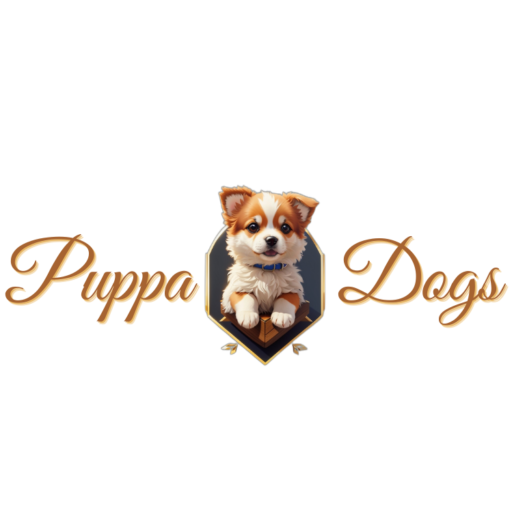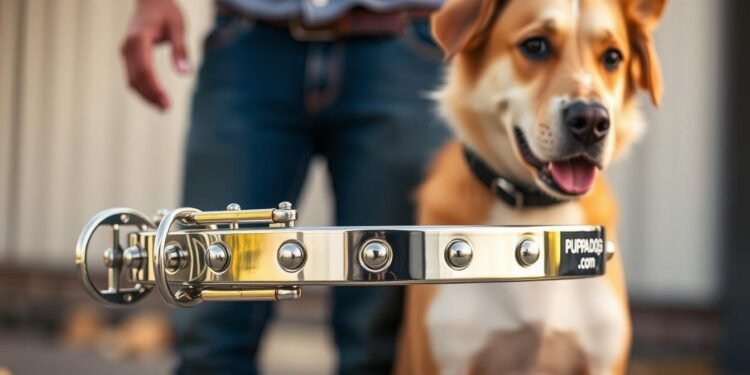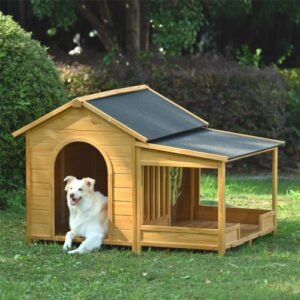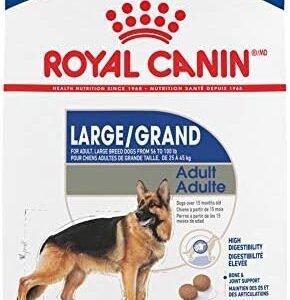Every dog owner knows the journey of training a pet can be rewarding and challenging. Seeing your dog master a command is a joy. But dealing with pulling on the leash or stubborn behavior can be frustrating.
As you explore different dog training techniques, you might have come across the prong collar. It has sparked debate among pet owners and trainers. Many wonder, “Is this the right approach for my dog?”
This article offers an unbiased look at the prong collar. We’ll discuss its function, effectiveness, and safety. We’ll also explore its benefits and drawbacks for dog training. With expert opinions and real user experiences, this guide aims to help you make an informed decision for your dog’s welfare and your peace of mind.
Table of Contents
Understanding Prong Collars: What Are They?
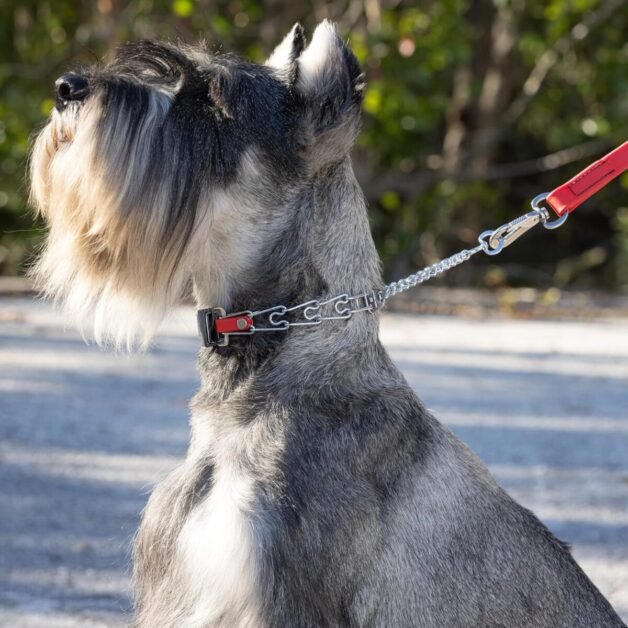
Prong collars, also known as pinch collars, are tools for dog training. They help owners control their dogs’ pulling during walks. The collar has metal links with prongs that pinch the dog’s neck when pulled tight.
This design is meant to mimic a mother dog’s way of guiding her puppies. Studies show prong collars can change behavior with much less effort than flat collars.
Many trainers see prong collars as useful, but they’re also debated. Critics worry about physical and mental harm, like bruises and discomfort. It’s key to use them correctly to avoid hurting the dog.
The collar’s placement near the thyroid gland raises concerns about hormonal issues. Owners must think carefully before using them.
Prong collars can help adult dogs that don’t respond to choke collars. They’re also good for puppies that pull too much. Knowing how and when to use these collars is important for dog care and training.
How to Use a Prong Collar for Training
Using a prong collar correctly is key to training your dog well and keeping them safe. Start by introducing the collar slowly, letting your dog get used to it. Dog training tips suggest using positive reinforcement with the collar for better results.
Effective training with a prong collar involves the right way to attach it and when to use corrections. Place the collar high on the dog’s neck, just behind the ears. Make sure the prongs face inward but don’t hurt the dog. It’s important to watch how your dog behaves during training to make the right changes.
| Aspect | Details |
|---|---|
| Usage Duration | Maximum of one hour at a time to prevent neck irritation |
| Leash Type | Recommended: 4-foot training leash for effective control |
| Correct Placement | Behind the ears and under the jawline for effectiveness |
| Adjustment Method | Add or remove links to fit the dog’s neck snugly |
| Initial Leash Attachment | Use the dead-ring to reduce correction intensity at first |
Watch for signs of discomfort, like stress or pulling too hard. If your dog seems uncomfortable, check the collar’s fit and use. Prong collars are for specific training times, not all the time. Talk to a professional dog trainer for help on fitting and using the collar right.
Advantages of Using a Prong Collar for Dogs

Prong collars have many benefits when used right in dog training. They help a lot, mainly with dogs that pull a lot. These collars give dogs instant feedback, helping handlers control them without hurting them.
Effective Control for Strong Pullers
The main prong collar benefit is controlling dogs that pull too much. Unlike regular collars, prong collars apply even pressure. This keeps the collar from getting too tight, which is safer for dogs.
Improvement in Training Sessions
Many owners see big changes in their dog’s behavior during training. Prong collars help dogs learn faster because they give consistent feedback. Adding positive reinforcement makes training more fun.
For more tips on training, check out this resource.
Prong collars are a useful tool for dog training when used right. They help correct bad behavior safely. They also help dogs and owners bond stronger.
Prong Collar Usage: Safety Measures to Consider
Using a prong collar safely means following important steps. These collars should only be used during training and not left on dogs all the time. It’s key to watch your dog closely to make sure the collar fits right and doesn’t hurt them. This is why dog training precautions are so important.
Make sure the collar fits snugly, just behind the ears and under the jaw. This helps it work best. Also, choose a 3 mm prong collar with short links for safety. This is better than the 2.25 mm prongs, which are often used for bigger dogs.
Having a different prong collar for each dog in the house is a good idea. This reduces the chance of mistakes. A strong backup system is also important for safe collar usage during walks. A safety clip or coupling strap can connect the prong to a backup collar.
Using the collar’s dead-ring during the first training sessions is safer. It reduces the impact of the correction. This makes training safer for your dog.
But, using a prong collar wrong can hurt your dog. It can cause skin problems or even harm the neck. Always watch how your dog reacts during training. If they seem scared or aggressive, it’s a sign something’s wrong.
Before starting to use a prong collar, know your dog well. Understand their personality and any health issues they might have. This helps in training them safely and effectively.
Prong Collar for Dogs: User Experiences
Dog owners share both good and bad about prong collars. They talk about how these tools work and common myths. Many say their dogs behave better, like not pulling as much. But, not everyone has a positive story.
Real Owner Testimonials
Many owners say prong collars help with walking. They say these collars work fast to keep dogs in line. But, some dogs don’t like them and may show it.
Seeing dogs still pull with collars on shows training issues. It’s key to fit and use them right to avoid problems.
Common Misconceptions and Clarifications
Some think prong collars are cruel. But, they work well if used right. Misunderstandings can make dogs stressed and act out.
Stress from prong collars is a big concern. It’s important to train dogs humanely. Looking into other training methods is wise.
Prong collars are designed to avoid harm to the throat. They’re different from flat collars that can hurt pullers. Learning from studies and experiences helps owners make better choices.
Prong Collar Training: Techniques that Work
Effective prong collar training combines different techniques. It starts with the right collar fit. The collar should sit just below the ears and fit snugly around the neck. This setup helps avoid discomfort and clearly communicates with the dog.
Positive reinforcement is key in dog training. Rewarding good behavior with treats or praise strengthens the bond. It’s important to teach commands that are easy for the dog to understand and reinforce positive actions.
As distractions grow, introducing them gradually helps the dog adapt and recall better. This is crucial for recall training. It’s also vital for all family members to use the same commands to avoid confusion.
Collars like the Herm Sprenger prong collars are known for their gentle guidance. They come in various sizes, from 2.25mm to 3.2mm, fitting different dog sizes and weights. Used carefully, they can greatly improve a dog’s behavior.

Prong Collar Benefits in Behavior Correction
Prong collars are great for fixing many dog behavior problems. They help with too much barking, jumping, and aggression. These tools help set clear rules and teach good habits.
Addressing Behavioral Issues
Prong collars help dogs and owners talk better. They make it easier to teach good behavior without using flat collars. For example, they help puppies learn fast, making training easier.
Owners who use them right can keep their dog’s behavior in check. This makes training sessions more effective.
Importance in Reducing Aggression
A prong collar can really help dogs that are too aggressive. It sets clear rules and keeps the environment stable. This is key for dogs that might get too rough.
Trainers say a level 7 correction is often the best start with a prong collar. It’s safer than choke collars and works well if other methods didn’t.
Prong Collar vs. Choke Collar: A Comparative Analysis
Dog owners need to understand the difference between prong and choke collars for effective training. Prong collars spread pressure evenly and prevent injury if fitted right. They help train dogs without harm.
Choke collars, though, can cause serious problems like tracheal damage or strangulation. They can also lead to muscle issues and bruises. The choice between these collars depends on the training method used.
Using either collar wrong can be very dangerous. Prong collars might bruise or puncture sensitive areas if not set right. This can even cause whiplash. Experts suggest fitting prong collars high on the neck and choke collars with a buckle.
Some places have banned prong collars due to animal welfare concerns. This shows the pain they can cause if used wrong. Instead, using harnesses or head halters can be safer and still effective. Knowing the right choice helps owners focus on their dog’s safety and well-being.
Best Prong Collar for Dogs: Top Picks Reviewed
Finding the right prong collar for dogs can make training better. Amazon helps by comparing products. This section looks at top picks, focusing on what they offer for different breeds.
Amazon Product Reviews
| Product Name | Material | Weight | Suitable Neck Size | Price Range |
|---|---|---|---|---|
| Herm Sprenger Prong Dog Training Collar | German Alloy Steel | 8.48 oz | Up to 18 inches | $25 – $35 |
| Easy-On Dog Prong Training Collar by Coastal Pet | Durable Nylon | 2.8 oz | Up to 20 inches | $15 – $25 |
| Black Stainless Steel Prong Dog Training Collar by Herm Sprenger | Stainless Steel | 3.21 oz | Up to 18 inches | $28 – $30 |
| Wellbro German Shepherd Pit Bull Metal Gear Training Prong Collar | Metal | 9.6 oz | Up to 24 inches | $20 – $30 |
| Darkyazi Pinch Durable Stainless Steel Pet Training Collar | Stainless Steel | 5.9 oz | Up to 22 inches | $16 – $22 |
- Flexible Connection: The ClicLock fastener allows the collar to be opened and closed comfortably without pulling it over…
- The Brand You Love: This Herm Sprenger training collar is an essential tool for dog training. This collar size is perfec…
- Removable Links: Adjust the collar length by removing or adding the links according to the size of the dog’s neck (extra…

- Prong Collar for Dogs: This dog training collar evenly distributes pressure around the dog’s neck
- No-Shock Training Collar: The prongs mimic a natural correction that one dog would give another
- Pinch Collar for Dogs: Limited closure prevents the collar from getting tight around the dog’s neck







- Black Stainless Steel Prong Collar: This model come with two O rings; Size Medium 3.2 mm x 23 inches overall collar leng…
- Removable Links: Slightly beveled prong tips: Interlocking links, each link equipped with two blunt prongs; Links can be…
- How to Size: Collar should fit snuggly just below the dog’s ears, measure the circumference of dog’s neck and add 3 inch…
- Measure the widest point of your dog’s head, wrapping under the chin and around the back of the head, right behind its e…
- Smooth, comfortable links won’t damage or pull out fur and make for one cool dog collar!
- Solid 316L Stainless Steel metal will not tarnish, rust, or irritate your dog’s skin.







- Pet training collar stylish design with metal buckle reinforces the fastness, offering easy on and easy off in a second
- No need to scream at a dog or punish it,You only have to pull the training collar and the dog will stop immediately, The…
- Prong training collar suit for all kinds of dog, You can remove and add back prong collar from the collar as needed to f…







Prong Collar Ranking Factors
Choosing a prong collar depends on several factors. Material quality is key for durability and comfort. Adjustability ensures a good fit, which is crucial for training.
Weight matters too, with lighter collars better for smaller breeds. Prices vary, offering options for all budgets. Reviews show that even pressure and proper fit are important for training.
Prong Collar Alternatives: What Are Your Options?
Looking for prong collar alternatives is key for dog owners wanting to train their pets gently. There are many dog training tools that help control dogs without hurting them. Tools like head halters and no-pull harnesses guide dogs softly and encourage good behavior.
Head halters, like the Gentle Leader® and NewTrix, control dogs without pain. They apply gentle pressure to the dog’s neck and muzzle. This helps dogs learn without fear or aggression.
- FOR SMALL DOGS – At only 4.7in (12cm), our Mini Collar Companion is a perfect fit for small dogs.
- SECURE CLIPS – Our double ended clips are swivel eye snap hooks, the most secure clip to use for pets. Because they requ…
- PREVENT ACCIDENTS – Our Mini Collar Companion’s primary purpose is to prevent accidents and to keep your dog safe if the…







No-pull harnesses, like the Freedom Harness and Easy Walk®, are safer than collars. They spread the force across the dog’s body, avoiding injuries. A hands-free leash, like the Buddy System®, lets owners give treats while keeping control. This encourages good behavior without using harsh methods.
- 【Effective Collar for Dogs】: Walking your dogs can be tough when they’re constantly pulling on the leash or barking at p…
- 【Humanity Protection Design】: Dogs Collar used round head and smooth surface, the collar for dogs provide necessary & fr…
- 【Quick Friendy Front Bukle】: This unique dog Collar shas a custom-designed front quick release buckle is friendly to you…







Choosing non-aversive training methods makes for a better bond between dogs and owners. As dog training improves, using kind methods builds trust and reduces stress. Making smart choices in dog training tools leads to better results for pets and their owners.
The Science Behind Aversive Training Methods
Aversive training methods, like prong collars, are debated in the dog training world. They are often used on big breeds, like pit bulls and Labradors. Some trainers say they work, but many worry about their effects on dogs’ feelings and health.
Research shows that aversive training can stop dogs from sniffing and exploring. This can make them confused and upset, which is worse for dogs trained with the wrong ideas. Dogs may get very anxious and stressed, which is bad for them, even more so if they’ve been hurt before.
Studies show dogs trained with aversives change a lot. They learn to be scared of wearing a collar. This fear can make them aggressive or act out in other bad ways. But, these methods don’t really teach dogs to walk well on a leash or listen to commands.
On the other hand, positive reinforcement is key in dog training. Many trainers use rewards to teach dogs, which works better in the long run. This builds a strong bond between dog and owner. Groups like the American Veterinary Society of Animal Behavior say to use gentle methods. They believe in fixing the problem, not just hiding it with discomfort.
Based on what we know, training methods should focus on a dog’s emotional health and learning. It’s important for trainers and owners to understand the effects of their choices.
Legality and Ethical Considerations of Prong Collars
The rules on prong collars differ a lot around the world. Countries like Austria and Switzerland have banned them. In the U.S., prong collars are still legal but many groups like the Humane Society are against them. They worry about how they’re used in dog training.
Many people don’t know how to use prong collars right. This can hurt dogs a lot, like their trachea and neck skin. It’s important to use them carefully.
Studies show that using punishment in dog training can harm them. It can make dogs less social and playful. Instead, positive training methods are better. They help dogs learn and feel good about it.
Now, more places are making rules for dog training. Some pet stores even let you swap prong collars for safer ones for free. This shows a shift towards safer training methods.
More people are learning about the best ways to train dogs. Insurance plans are starting to cover training for problems like separation anxiety. This shows a big change in how we care for pets.
Even though prong collars are still legal for some, it’s important to think about what’s best for dogs. We should avoid training methods that scare or upset them. It’s all about keeping our pets happy and healthy.
















